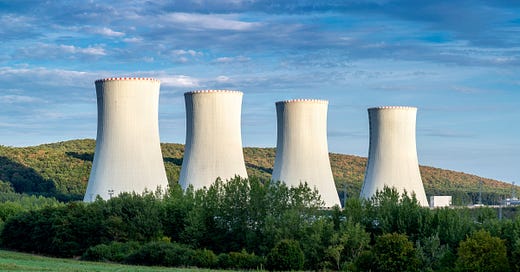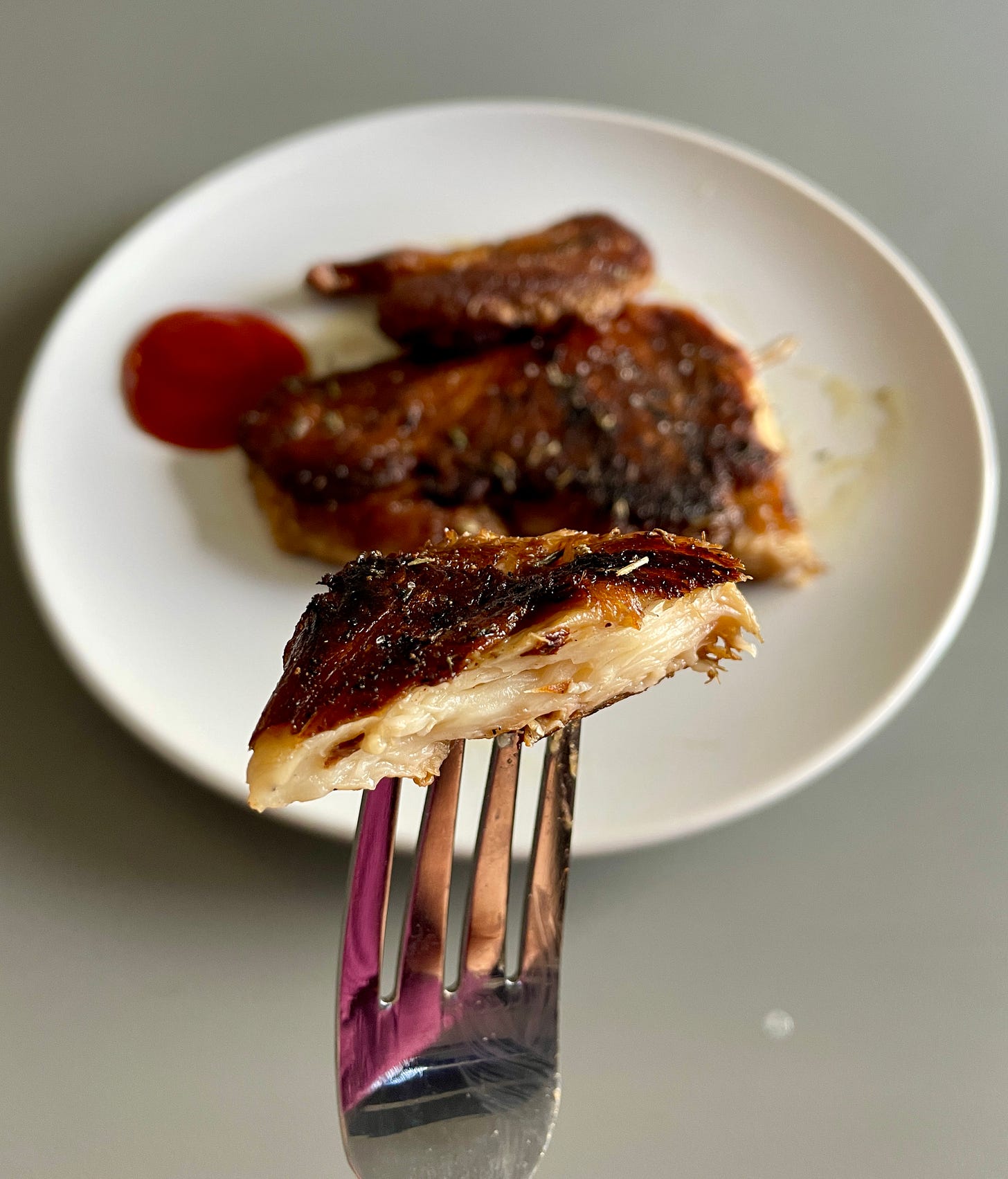BRB w/ Nathan P – Nuclear Fission, Lion's Mane Steak & The Happiness Advantage
The nuclear question post-Oppenheimer, cooking mushrooms like a steak, and 3 tips on positive psychology from an unusual Harvard researcher (#28).
Hi all,
We’ve had a ton of new subscribers in the past month – welcome everyone 🥳
Thank you for joining this community of environmentalists, foodies, entrepreneurs, and investors committed to a healthier planet. I’m glad you’re here.
For those I haven’t met yet, my name is Nathan Paumier. I’m a French-American food enthusiast, design thinker, and climate optimist. I studied Environmental Engineering at Yale and am now combining my passions for food and climate at BioBrew, AB InBev’s precision fermentation venture.
I love meeting new people – please reach out and let me know how I can be a resource.
Welcome back to BRB w/ Nathan P, a weekly newsletter featuring 💥1 Breakthrough, 🥘1 Recipe, and 📚1 Book on food & climate.
Before we get started, here are some highlights of food & climate in the news this week:
DOE commits $450M to install rooftop solar for highest-need Puerto Ricans (Grist)
Tree Keepers: Where Sustaining the Forest Is a Tribal Tradition (Yale360). Interesting read on sustainable forestry from indigenous traditions.
💥 Breakthrough: Nuclear Fission
Barbie & Oppenheimer have been all the rage the past few weeks. After seeing Oppenheimer on Friday – though I’ll confess I saw Barbie first 👀 – I am devoting this week’s BRB to nuclear fission.
Today we’ll cover:
How Nuclear Fission Works
The Case for Nuclear Energy: Benefits & Risks
Recent Safety Breakthroughs
The technologies from the invention of the atomic bomb built the foundations for nuclear power plants. These both rely on nuclear fission, which splits the atom to release energy.
Note: nuclear fission is different from nuclear fusion, a groundbreaking technology that is still many years away.
How Nuclear Fission Works
Nuclear fission is typically performed using uranium or plutonium, two heavy radioactive metals.
When uranium accepts an extra neutron – the neutral particle in the atom’s nucleus – it splits into two atoms and releases extra neutrons (in addition to energy). These extra neutrons can then bump into more uranium atoms, starting a chain reaction.

When uncontrolled, this chain reaction can create massive explosions, e.g. an atomic bomb. Nuclear power plants use this technology in a controlled manner to generate electricity.
In a nuclear reactor, uranium pellets are stored in rods housed in an assembly with water to control the reaction. As energy is released during nuclear fission, heating water to create pressurized steam that can turn a turbine and generate electricity.
The Case for Nuclear Energy: Benefits & Risks
Here’s the one-sentence pitch for fission: Nuclear fission is the only non-carbon emitting source of energy that can deliver power any time, any where, and has been proven at commercial scale.
Yet after the incidents of Chernobyl in Ukraine, Three Mile Island in Pennsylvania, and Fukushima in Japan, public opinion is understandably hesitant and concerned.
On the one hand, nuclear fission has many benefits:
✅ It is a clean, carbon-free energy source
✅ It can be deployed anywhere, regardless of geography
✅ It is proven at large scale, powering 70% of France today
✅ It has no intermittency issues, creating power when needed
✅ It has a high power density, producing 30X the power of wind or solar on the same land area.
On the other hand, nuclear fission does have risks and downsides that should not be overlooked:
❌ Nuclear waste is harmful and must be properly managed
❌ Building new facilities has high capital expenditure
❌ There are risks of developing nuclear weapons
❌ Human error can lead to accidents
With that said, these are not necessarily reasons to abandon nuclear energy. When people realized cars were dangerous, we didn’t just ban them. Instead, we used innovation to make them safer with seatbelts, airbags, and other technologies.
Recent Safety Breakthroughs
Scientists are pioneering next-generation nuclear reactors with inherent safety features. Bill Gates has funneled $10B since 2008 into his nuclear innovation company TerraPower to make nuclear power safer. Here are a few key innovations:
☢️ Existing nuclear waste can be used to create more energy
🧂 Molten salt is used a coolant, which expands if overheating occurs and slows down the nuclear reaction
💉 The reactor is shaped like a syringe, which can expand to also slow down the nuclear reaction
These innovations prevent accidents without the need for human intervention – just using the laws of physics. One episode in Netflix’s Inside Bill’s Brain dives into this further.
I think nuclear energy has the potential to drastically reduce carbon emissions from energy production and curb climate change, and it is unfortunate it has been largely abandoned in the US. I’m curious to hear your thoughts in the comments.
🥘 Recipe: Lion’s Mane Steak
If I had to pick a favorite mushroom (and my friends know I have many) – it might have to be lion’s mane.
Lion’s mane gets its name from its shape. You might have seen lion’s mane in mushroom coffee products, as it contains compounds for brain health that regenerate the myelin sheath on neurons. It increases focus and might even prevent Alzheimer’s.
I cooked this mushroom similar to how steak is cooked: with high heat and steak seasoning. It was as delicious as it looks.
If you make it, please send pictures :)
📚 Book: The Happiness Advantage
Shawn Achor is the speaker behind my favorite TED talk ever. If you have 12 minutes this week, I promise you’ll get a laugh and habits to make you happier.
As a break from traditional books on food and climate, I want to include a book to help us cope with the anxieties and uncertainty around climate change.
Shawn Achor helps schools and businesses increase performance through positive psychology. His book focuses on 7 principles from positive psychology that have improved my well-being, gratitude, and priorities since I read it 4 years ago.
It focuses on a key paradigm shift we all need to embrace. We often believe that if we work harder now, then we’ll be happier. Instead, it’s the opposite: those who prioritize happiness are more productive and successful in the long-run.
My 3 favorite tips from his book, and how it can apply to food & climate:
Every day, write down 3 new things you are grateful for (cheesy, I know). By learning to scan the world for positives, we become happier and more optimistic.
Reduce information intake by 5%: reading articles and articles of negative climate news does not inspire action.
The 20-second rule: align your goals with the path of least resistance. Make it take less than 20-seconds to start the tasks you want to focus on (e.g. preparing gym clothes in advance) and more than 20-seconds to start the tasks you want to avoid (e.g. putting snacks far away / not keeping them at home).
Thank you for reading – BRB next week ✌️
🥘 Recipe: Lion’s Mane Steak
Ingredients:
One large lion’s mane mushroom, 150-200g
Vegetable oil with high smoke point (avocado or canola)
Seasoning with 3g of each: salt, paprika, thyme, garlic powder
Instructions:
Heat a skillet on high heat with vegetable oil.
When it starts to smoke, place the entire lion’s mane mushroom, and press down with another pan or flat lid. After searing for a few minutes, flip to the other side and press down until flattened.
Add spices to one side, then lower the heat. Flip and add spices to the other side.
Turn heat to low to cook for a few more minutes, then optionally baste with butter.
Enjoy with your besties :)
About Me
Hi there! My name is Nathan Paumier - I’m an avid reader, food enthusiast, and climate optimist. I started this newsletter after frequent questions on food tech, reading recommendations, and my secret recipes.
Want to get in touch or chat further? Anything you’d like to hear more of?
Forwarded this email?
Subscribe below to receive an email from me every week.
No spam, just quality ingredients.








